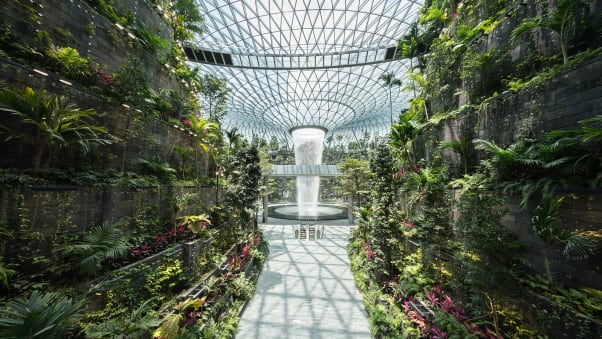Changi Airport Singapore’s world’s tallest indoor waterfall

Inside Changi Airport Singapore’s new ‘Jewel,’ home to world’s tallest indoor waterfall Following four years of construction and nonstop media coverage, Singapore’s long-awaited Jewel Changi Airport is officially open.
Featuring a dramatic, doughnut-shaped exterior framed in steel and glass, the 135,700-square-meter space (around 1.46 million square feet) is a multi-use complex designed to connect three of Changi Airport’s four terminals.
But above all, the April 17 opening confirms long-held suspicions that yes, the “world’s best airport” is now even better and will likely hold onto its top spot on the Skytrax rankings, which it has dominated for the past seven years, for the foreseeable future.
Built at a cost of SG$1.7 billion (about US$1.25 billion) and designed by renowned architect Moshe Safdie, Jewel has 10 stories — five above ground and five in the basement.
The star attraction is the 40-meter-tall (around 130 feet) HSBC Rain Vortex, which cascades through a huge oculus in the middle of Jewel and is billed as the world’s tallest indoor waterfall.
It’s a dramatic site that’s usually heard before it’s seen as passengers exit the retail and dining zones that wrap around the Jewel’s outer sections and head toward the center, where they’re met with the thunderous sounds of a waterfall that appears to fall from the sky.
Jewel Changi Airport is now open: The centerpiece of Singapore’s highly anticipated new Jewel Changi Airport is the Rain Vortex. At 130 feet in height, it’s the world’s tallest indoor waterfall.
Containing over 280 retail and food/beverage outlets, Jewel Changi Airport could easily be written off as a beautiful shopping mall filled with dramatic green spaces that just happens to be connected to an airport.
After all, it’s not an airport terminal — there are no boarding gates or arrival halls, and anyone can visit.
The new Changi addition serves multiple purposes for travelers. In addition to linking Terminals 1, 2 and 3 (passengers heading to and from Terminal 4 need to take a shuttle bus), offerings include early check-in services and baggage storage facilities as well as a 130-cabin YOTELAIR Singapore Changi Airport hotel.
There’s also the Changi Lounge, designed to complement a new intermodal transfer service that improves air-sea connectivity for cruise passengers.Beyond expected amenities like free Wifi, Jewel offers a few little nice touches like power bank loans — free for 12 hours.
A Skytrain, which connects Changi terminals 1, 2 and 3, cuts through the middle of the Jewel. It goes by the Vortex and adds to the photogenic scene.On the top floor is the 14,000-square-meter Canopy Park, which has several restaurants and themed gardens. Though some sections are open, work is still underway on this one. The park’s Canopy Mazes, Sky Nets, Discovery Slides and 50-meter Canopy Bridge won’t be ready until mid-2019.
The back story behind Jewel’s development is basically Joni Mitchell’s “Big Yellow Taxi” in reverse. Changi Airport Group has essentially turned a parking lot into an indoor paradise, inspired by Singapore’s reputation as a “city in a garden.”
“Back in 2010 we were looking at expanding the capacity of Terminal 1 and we decided that the open-air parking structure could potentially become a new integrated complex,” says Goh.That car park was transformed into the stunning space that now stands in its place, a marvel for those who have been following Jewel Changi Airport’s progress since 2013, when news of the airport expansion — then simply named “Project Jewel” — first broke.
“I wanted to explore a new kind of urban space, a space you go to as a matter of course, because you need to shop, because you’re flying out somewhere, and yet it’s a garden — somewhere that says ‘let’s rethink what the public realm is, let’s rethink what it is to shop,'” Safdie told.
“I think one of the reasons [we won] the bid was that the other submissions looked like malls and felt like malls, while this one, you don’t think of it as a mall, because it’s a new kind of experience. It makes us rethink what urban centers could be like if we stretch our thinking.”
Planning for a massive Terminal 5 — which will be about the size of all four terminals put together — is now underway, with the facility expected to open after 2030.
Beginning later this year, Singapore’s Changi Airport Terminal 2 is set to undergo a five-year expansion project that will include an overhaul of the departure check-in hall and transit area.
“With the addition of the new capacity in Terminal 2, that will bring the overall passenger capacity of Changi airport to 90 million passengers per annum, and with Terminal 5, we have current plans to add another 50 million passenger-per-annum capacity,” says Goh.
“So, by 2030, if everything goes according to plan, we’ll have a total of about 140 million passenger-per-annum capacity at Changi.”





